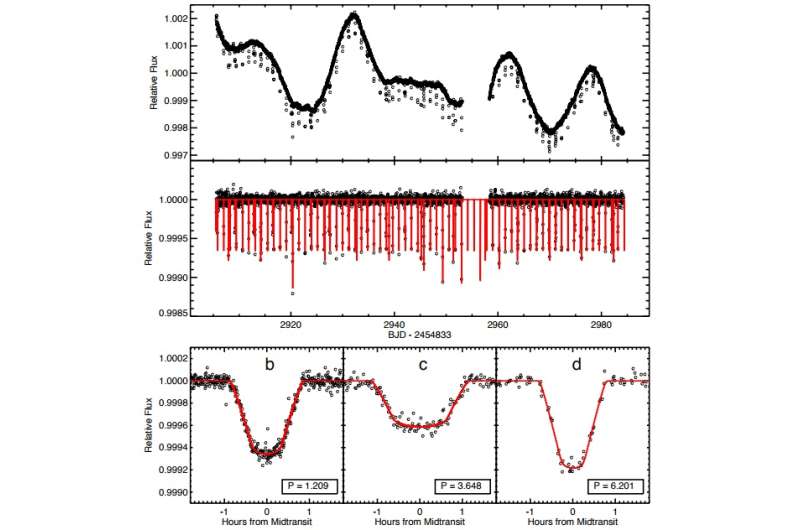September 13, 2017 report
Three 'super-Earth' exoplanets orbiting nearby star discovered

(Phys.org)—NASA's prolonged Kepler mission, known as K2, has made another significant discovery, revealing the existence of three new exoplanets. The newly found alien worlds circle the nearby star GJ 9827 and were classified as "super-Earths." The finding is presented in a paper published Sept. 6 on arXiv.org.
Kepler is the most prolific planet-hunting telescope. The spacecraft has discovered more than 2,300 exoplanets to date. After the failure of its two reaction wheels in 2013, the mission was repurposed as K2 to perform high-precision photometry of selected fields in the ecliptic. Since then, the revived Kepler spacecraft has detected nearly 160 extrasolar worlds.
Now, a team of astronomers led by Joseph Rodriguez of the Harvard-Smithsonian Center for Astrophysics (CfA) in Cambridge, Massachusetts, reports the finding of three new exoplanets from the data provided by K2. The Kepler spacecraft observed GJ 9827 from December 2016 to March 2017, during its Campaign 12. These observations allowed the team to discover that this nearby late K-type dwarf star is orbited by three alien worlds. The newly found planets were classified as "super-Earths" as they have masses higher than Earth's but lower than that of Solar System's gas giants.
"In this paper, we present the discovery of three transiting planets orbiting the nearby star GJ 9827 using data from the K2 mission," the researchers wrote in the paper.
Located some 100 light years away from the Earth, GJ 9827 is a bright star of spectral type K6V. It has a radius of about 0.63 solar radii and is approximately 15 percent less massive than our Sun. The scientists found that the star is circled by three planets, designated GJ 9827 b, c and d, located about 0.02, 0.04 and 0.06 AU from the host respectively.
According to the paper, GJ 9827 b has a radius of 1.64 Earth radii but its precise mass remains uncertain. The researchers estimate that its mass should be between 3.5 and 4.26 Earth masses. The planet orbits its parent star in approximately 1.21 days and has an equilibrium temperature of 1,119 K.
With a radius of 1.29 Earth radii and an estimated mass of about 2.5 Earth masses, GJ 9827 c is smallest and less massive planets of the newly discovered trio. The exoplanet has an equilibrium temperature of 774 K and an orbital period of 3.65 days.
GJ 9827 d is about two times larger than the Earth and at least five times as massive as our planet. This alien world has an equilibrium temperature of 648 K and it takes it 6.2 days to fully orbit its host star.
The new discovery reported by Rodriguez's team makes GJ 9827 the closest exoplanet host discovered by K2 mission to date. The star's proximity and brightness as well as similarity in the size of planets make the system an excellent target for further atmospheric studies. The scientists hope that future space observatories like the James Webb Space Telescope (JWST) could provide important insights about atmospheric properties of the three newly discovered extrasolar worlds.
More information: A System of Three Super Earths Transiting the Late K-Dwarf GJ 9827 at Thirty Parsecs, arXiv:1709.01957 [astro-ph.EP] arxiv.org/abs/1709.01957
Abstract
We report the discovery of three small transiting planets orbiting GJ 9827, a bright (K = 7.2) nearby late K-type dwarf star. GJ 9827 hosts a 1.64+0.22−0.20 R⊕ super Earth on a 1.2 day period, a 1.29+0.17−0.16 R⊕ super Earth on a 3.6 day period, and a 2.08+0.28−0.26 R⊕ super Earth on a 6.2 day period. The radii of the planets transiting GJ 9827 span the transition between predominantly rocky and gaseous planets, and GJ 9827 b and c fall in or close to the known gap in the radius distribution of small planets between these populations. At a distance of ∼30 parsecs, GJ 9827 is the closest exoplanet host discovered by K2 to date, making these planets well-suited for atmospheric studies with the upcoming James Webb Space Telescope. The GJ 9827 system provides a valuable opportunity to characterize interior structure and atmospheric properties of coeval planets spanning the rocky to gaseous transition.
© 2017 Phys.org




















